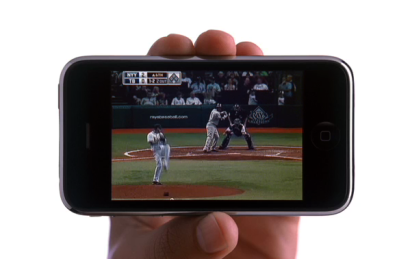In an observation that should surprise no one except a few cave-dwellers, a new study from NATPE/Content First and the Consumer Electronics Association has found that millennials find Netflix subscriptions more valuable than broadcast and cable subscriptions. There are, however, some useful insights to be gleaned if we look a little deeper.
The study found that “51 percent of millennials consider Netflix subscriptions very valuable, compared to 42 percent for broadcast channels and 36 percent for cable subscriptions. Young people are also more likely to stream a full-length TV program than watch it live on TV during its original air time or time-delayed on a DVR,” according to The Hollywood Reporter.
The story goes on to note that not many millennials (people of ages 13 through 34) have given up on TV—in fact, the proportion is only five percentage points higher than among other age groups:
The study also found that 90 percent of viewers say they watch television programming on a TV set compared to 85 percent of millennials who count a TV as their preferred screen for viewing that content. That’s still a relatively high figure but is likely to shrink given that the study also found that only 55 percent of millennials prefer to watch television on a TV set.
The NAPTE representative also noted more than 70 percent of viewers in households with broadband have streamed full-length TV programs in the past six months. That seems to mark a significant movement, but this too is a trend we have been seeing for some time.
The study pointed out that millennials like streaming because it is more mobile than watching on a TV set (again, obviously), and that 28 percent of the age group watch television on a tablet. The announcement, given on Thursday at the Consumer Electronics Show in Las Vegas, did not specify precisely how much television millennials watch on tablets, or what proportion of their television they watch on them, but presumably that information will be made available when the full study is released at the end of this month.
The essence appears to be that the younger the person, the more likely he or she is to watch TV on a mobile device. I suspect that there are a couple of factors at play here in addition to the belief that young people are more open to new technologies than their elders.
One, my personal observation has been that young people are doing much more of their viewing on smartphones than ever before, which is something older people with less visual acuity will have difficulty adopting in any great numbers. This should accelerate as phone screens increase in size. Two, although TVs are relatively cheap, rental of cable and satellite set-top boxes is not, meaning that young people are surely less likely than their elders to have regular control over a full-size TV set than a phone or tablet.
Hence it seems clear that young people’s migration to broadband is a matter of both convenience and necessity.
The Hollywood Reporter story observes that TV providers must and will adapt to this mobile revolution, quoting CEA chief executive Gary Shapiro as saying, “This has profound implications for the way CE manufacturers market their products as they try to reach diverse markets.”
The article then notes some of these efforts: “Dish announced during CES that it would go after that audience with Sling TV, an over-the-top streaming service that it wants to be the third subscription for a millennial alongside Netflix and Hulu. Meanwhile, CBS recently launched OTT offering CBS All Access and HBO has announced plans for a standalone streaming service.”
I’ve reported on the CBS and HBO services earlier, and the Sling TV announcement is certainly the next step in the process. For $20 a month, the individual will receive, over the internet, 25 to 30 channels, including ESPN, ESPN2, TNT, TBS, CNN, Food Network, HGTV, Cartoon Network, Adult Swim, and the Disney Channel. Additional bundles, such as news and children’s programming, will be made available for an extra $5 per month apiece.
You may have noticed that I wrote “an individual” above, and that’s the catch: the service can’t be viewed on multiple TVs or devices simultaneously. Hence it’s not for families but for individuals who probably would not be able to afford cable or satellite TV anyway. Although some people may use it to “cut the cord” (by substituting another, ironically), it’s unlikely to replace cable and satellite subscriptions altogether. Everybody wins.
Thus, as I’ve noted earlier, even though market forces and new technology are changing the nation’s viewing habits, the only thing that can cause a serious and unnecessary dislocation of the nation’s television distribution system is government, and the Obama administration is on a quest to do just that.
While providers are busy creating cheaper and more convenient ways to get video-based news and entertainment, and consumers are eagerly taking advantage of every opportunity, the national government is doing all it can to suppress this salutary revolution while claiming it is doing so in order to promote competition. Here’s a great way to do that, Mr. President: get out of the damn way.

